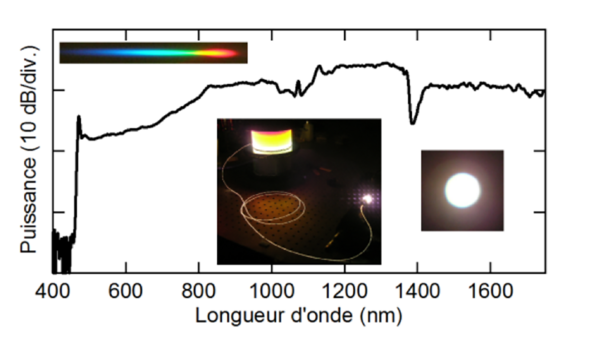1) Hydrodynamic / optical analogy
Page en attente de traduction / Page awaiting translation
Cette thématique a été initiée en 2008 au sein du groupe, alors qu’une course effrénée était lancée au niveau international concernant la montée en puissance des sources supercontinuum blanches à fibre optique. Elles étaient en effet limitées à une puissance moyenne totale de 4 W à cette époque. L’originalité de nos travaux a porté sur l’utilisation de lasers à fibre continus, dont la puissance moyenne dépasse fortement celle des sources impulsionnelles habituellement utilisées. Nous avons alors cherché à compenser la faible puissance « crête »de ces sourcescontinues (de l’ordre de quelques dizaines de watts) par une augmentation dela longueur des fibres dans lesquelles se produisent les effets non-linéaires, et surtout par une optimisation minutieuse de leurs propriétés. Ainsi, en utilisant des fibres microstructurées effilées sur typiquement 100 m et en optimisant le dopage germanium du cœur, nous avons démontré la première source blanche continue, dont la puissance moyenne de 10 W constituait un record en 2010 [1]. Ces travaux ont suscité un vif intérêt de la communauté puisqu’ils ont été mis à l’honneur dans différentes revues industrielles (PhotonicsSpectra, Photoniques) et de diffusion scientifique (Science & Avenir, journal du CNRS).
Par ailleurs, nous nous sommes intéressés aux caractéristiques temporelles de ces sources, primordiales pour certaines applications et qui s’inscrivent dans le cadre général et plus fondamental de celui des ondes scélérates optiques. Nous avons montré qu’elles résultent de la collision de solitons [2] et que l’ingrédient minimum et nécessaire pour leur apparition est la dispersion d’ordre trois [3]. Ces études fondamentales nous ont permis de mettre au point une solution passive pour stabiliser temporellement les sources supercontinuum [4]. Nous avons bénéficié auprès d’OSEO et du CNRS du financement d’un ingénieur (1 an) pour développer un prototype qui présente des instabilités bien plus faibles que les modèles commerciaux (3 à 4 fois plus stable).

Spectre de la source supercontinuum blanche et continue et photos de l’expérience.
